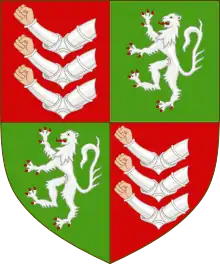John Heaton-Armstrong
Sir John Dunamace Heaton-Armstrong MVO (21 February 1888 – 27 August 1967) was a long-serving English officer of arms at the College of Arms in London.[1]
Early life and education
Heaton-Armstrong was born at Salisbury House, Edmonton, the son of the Austrian-born politician and businessman William Heaton-Armstrong and his wife, Baroness Bertha Adalberta Maximiliana Zois-Edelstein, who came from an ennobled Habsburg family. She was the granddaughter of Karl von Zois, whose brother was Sigmund Zois. Heaton-Armstrong was educated at Eton College and Trinity Hall, Cambridge.[1]
Military service
During the First World War, Heaton-Armstrong was commissioned into the Cavalry Branch of the Reserve of Officers of the British Indian Army as a second lieutenant,[2] and was later promoted to lieutenant.[3] His first heraldic appointment at the College came on 6 April 1922, when he was made Rouge Dragon Pursuivant of Arms in Ordinary. On 14 October 1926, Heaton-Armstrong was promoted to the position of Chester Herald of Arms in Ordinary.[4] This office was made vacant by the promotion of Arthur Cochrane to the office of Norroy King of Arms. He was made a Member of the Royal Victorian Order (fourth class) (MVO) in 1937.[5] While holding this post, Heaton-Armstrong took a leave from the College of Arms to fight in World War II.[6] During this conflict, he rose to the rank of squadron leader in the Administrative and Special Duties Branch of the Royal Air Force.[7][8] He relinquished his commission in 1944,[9] and returned to the College of Arms, and was knighted in the Coronation Honours of 1953.[10][11]
Service as Clarenceux King of Arms
In 1956, with the death of Archibald George Blomefield Russel, Heaton-Armstrong was promoted to the office of Clarenceux King of Arms.[12] As such, he was responsible for the granting of arms in his jurisdiction south of the River Trent. While Chester Herald, Heaton-Armstrong was appointed to the honorary post of Inspector of Royal Air Force Badges, which post he held for the rest of his life.[13] Heaton-Armstrong continued to serve as Clarenceux until his own death in late 1967.[14]
Arms
 |
|
See also
References
- "Obituary: Sir J. Heaton-Armstrong". The Times. The Times Digital Archive. 29 August 1967. p. 8.
- "No. 29316". The London Gazette. 5 October 1915. p. 9774.
- "No. 30236". The London Gazette. 17 August 1917. p. 8462.
- "No. 33214". The London Gazette. 22 October 1926. p. 6749.
- "No. 34398". The London Gazette. 14 May 1937. p. 3182.
- "No. 34718". The London Gazette (Supplement). 27 October 1939. p. 7184.
- "No. 35076". The London Gazette. 14 February 1941. p. 909.
- "No. 35503". The London Gazette. 27 March 1942. pp. 1391–1392.
- "No. 36643". The London Gazette (Supplement). 4 August 1944. pp. 3670–3671.
- "No. 39863". The London Gazette (Supplement). 26 May 1953. p. 2941.
- "No. 39904". The London Gazette. 3 July 1953. p. 3676.
- "No. 40695". The London Gazette. 27 January 1956. p. 566.
- "No. 44755". The London Gazette. 31 December 1968. p. 13920.
- "Clarenceux King of Arms | British History Online". www.british-history.ac.uk. Retrieved 21 November 2018.
External links
| Heraldic offices | ||
|---|---|---|
| Preceded by Arthur Cochrane |
Chester Herald 1926 – 1956 |
Succeeded by James Frere |